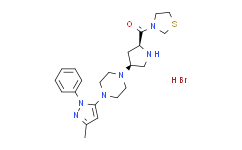Teneligliptin (MP-513) inhibits all these DPP-4 enzymes in a concentration-dependent manner. The IC50s of Teneligliptin for rhDPP-4, human plasma, and rat plasma are 0.889, 1.75, and 1.35 nM, respectively. A study of enzyme inhibition kinetics is conducted for Teneligliptin (MP-513) using Gly-Pro-MCA as the substrate and rhDPP-4 as the enzyme source. Plots based on the Michaelis-Menten equation reveals that Teneligliptin (MP-513) inhibits DPP-4 in a substrate-competitivemanner; the residual sum of squares for competitive and non-competitive models is 0.162 and 0.192, respectively. Ki, Km, and Vmax values are 0.406 nM, 24 μM, and 6.06 nmol/min, respectively. Teneligliptin (MP-513) inhibits the degradation of GLP-1(7-36)amide with an IC50 of 2.92 nM.
Medlife has not independently confirmed the accuracy of these methods. They are for reference only.



 扫码关注公众号
扫码关注公众号